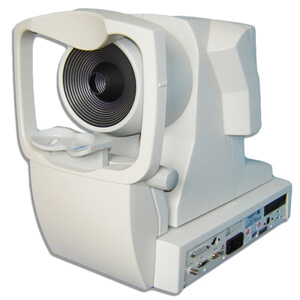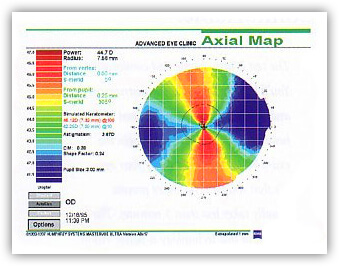 Carl Zeiss Meditec is an international giant in the field of manufacturing and distributing high-end optics and optical products.
Carl Zeiss Meditec is an international giant in the field of manufacturing and distributing high-end optics and optical products.
The greatest advantage of corneal topography is its ability to detect irregular conditions of your cornea invisible to most conventional testing. And because the computer can save your exam information, Dr. Seibel can monitor any changes to your cornea and/or your corneal stability over time.

Corneal topography is a computer assisted diagnostic tool that creates a three-dimensional map of the surface curvature of your cornea. The Zeiss Atlas 995 Topographer is the most innovative tool of its kind.
The cornea (the front window of the eye) is responsible for about 70 percent of the eye’s focusing power. An eye with normal vision has an evenly rounded cornea, but if the cornea is too flat, too steep, or unevenly curved, less than perfect vision results.
The Atlas 995 corneal topographer consists of a computer linked to a lighted bowl that contains a pattern of rings. During a diagnostic test, you would sit in front of the bowl with your head pressed against a bar while a series of data points are generated. Computer software digitizes these data points to produce a printout of the corneal shape, using different colors to identify different elevations, much like a topographic map of the earth displays changes in the land surface. This is a painless and brief non-contact test.

Corneal mapping reveals patterns indicating conditions that may affect the selection of the best type of vision correction or treatment for you. These patterns are color-coded according to highs and lows – red being the highest and purple being the lowest, in a continuous rainbow order. A few examples of corneal color maps are shown below.

Corneal topography produces a detailed, visual description of the shape and power of your cornea. This type of analysis provides Dr. Seibel with very fine details regarding the condition of your corneal surface. These details are used to diagnose, monitor, and treat various eye conditions. They are also used in fitting contact lenses and for planning surgery, including LASIK.
For LASIK the corneal topography map is used in conjunction with other tests to determine exactly how much corneal tissue will be removed to correct vision and with what LASIK pattern.
At Seibel Vision Surgery, your eyes and vision are of paramount importance. To help you make the most informed decisions regarding the welfare of your vision, we are delighted to be of service and are happy to answer any questions you may have.
Please take the time to familiarize yourself with the information contained on this site. We have compiled it especially for you!
Monday, Tuesday, Wednesday, and Thursday
8:30 a.m. to 3:30 p.m.
Friday
8:30 a.m. to 3:00 p.m.
OUR ADDRESS
11620 Wilshire Boulevard, Suite 711
Los Angeles, California 90025
PHONE
(310) 444-1134
FAX
(310) 444-1130
Learn about cataracts and their treatment
Learn more about CataractsGlaucoma, Macular Degeneration,
Medical Eye Exams, and other